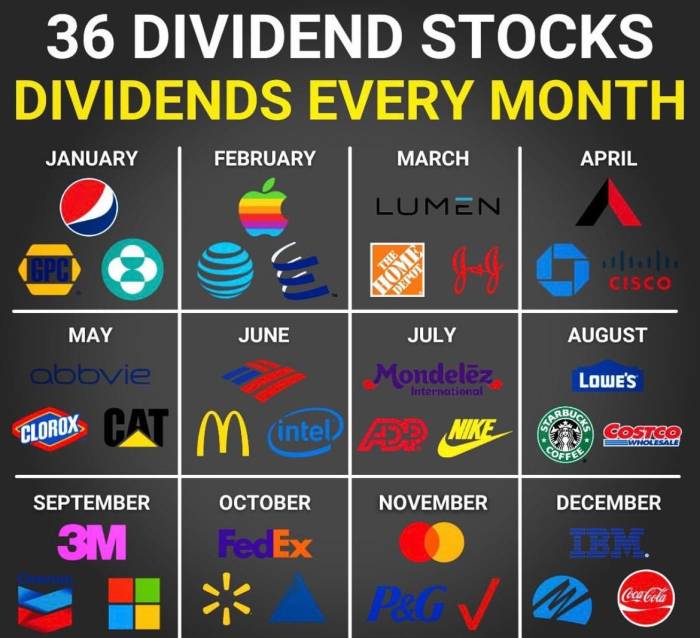Get ready to dive into the world of high-dividend yield stocks, where lucrative opportunities await those who seek to maximize their investment potential. With a blend of financial wisdom and strategic insight, this guide will equip you with the knowledge needed to navigate the exciting realm of high-yield stocks like a pro.
As we explore the nuances of high-dividend yield stocks, you’ll gain a deeper understanding of how to leverage these investments to your advantage and build a robust portfolio that stands the test of time.
What are high-dividend yield stocks?
High-dividend yield stocks are stocks of companies that pay out a significant portion of their earnings to shareholders in the form of dividends. These stocks are attractive to investors looking for a steady income stream in addition to potential capital appreciation.
Dividend Yield Calculation
Dividend yield is calculated by dividing the annual dividend per share by the stock price, then multiplying by 100 to get a percentage. The formula is:
Dividend Yield = (Dividend per Share / Stock Price) x 100
Examples of High-Dividend Yield Stocks
- AT&T Inc. (T) – Known for its consistent dividend payments and high yield.
- Verizon Communications Inc. (VZ) – Another telecommunications company with a strong dividend track record.
- Exxon Mobil Corporation (XOM) – A major player in the energy sector that offers high dividends.
Benefits of Investing in High-Dividend Yield Stocks
Investing in high-dividend yield stocks can provide investors with a steady income stream, which can be especially beneficial for retirees or those looking for passive income. Additionally, these stocks can offer a cushion during market downturns and historically have shown resilience in challenging economic conditions.
Factors to consider when selecting high-dividend yield stocks

When choosing high-dividend yield stocks, there are several important factors to consider to ensure a successful investment strategy. It is crucial to analyze company stability and growth, evaluate the sustainability of dividend payments, compare dividend yields across different sectors, and understand how economic conditions can impact these stocks.
Importance of company stability and growth
Company stability and growth are key factors to consider when selecting high-dividend yield stocks. A stable company with a history of consistent earnings and growth is more likely to sustain its dividend payments over time. Look for companies with strong financials, low debt levels, and a proven track record of profitability.
Evaluating the sustainability of dividend payments
To determine the sustainability of dividend payments, investors should analyze the company’s cash flow, payout ratio, and dividend history. A low payout ratio indicates that a company is retaining enough earnings to cover its dividend payments in the future. Additionally, a long history of paying dividends and consistent growth in dividend payments are positive signs.
Comparing dividend yield across different sectors
Different sectors offer varying dividend yields based on their industry dynamics, profitability, and growth prospects. It is essential to compare dividend yields within the same sector to identify potential investment opportunities. Some sectors traditionally offer higher dividend yields, such as utilities and real estate investment trusts (REITs).
Impact of economic conditions on high-dividend yield stocks
Economic conditions can significantly impact high-dividend yield stocks. In times of economic downturn or market volatility, companies may struggle to maintain dividend payments if their earnings are affected. It is crucial to assess how a company’s business model and industry sector can withstand economic challenges and continue to generate steady income for shareholders.
Strategies for building a high-dividend yield stocks portfolio
When it comes to building a high-dividend yield stocks portfolio, there are several key strategies to consider. By implementing these strategies, investors can maximize their returns and create a balanced portfolio that offers both income and growth potential.
The concept of diversification in dividend stock investing
Diversification is a crucial strategy when it comes to investing in high-dividend yield stocks. By spreading your investments across different sectors and industries, you can reduce the risk of significant losses if one sector underperforms. This way, you can protect your portfolio from market volatility and ensure a more stable income stream from dividends.
Provide tips for balancing high-yield stocks with growth stocks
Balancing high-yield stocks with growth stocks is essential for creating a well-rounded portfolio. While high-yield stocks provide steady income, growth stocks offer the potential for capital appreciation. By combining the two, investors can benefit from both income and growth opportunities, ensuring a more balanced and diversified portfolio.
Discuss the role of reinvesting dividends for long-term growth
Reinvesting dividends is a powerful strategy for long-term growth. Instead of taking the cash payouts from dividends, investors can reinvest them back into the stocks, buying more shares and compounding their returns over time. This can significantly increase the overall value of the portfolio and accelerate wealth accumulation in the long run.
Explain how to adjust a portfolio based on changing market conditions
Adapting your portfolio based on changing market conditions is crucial for maintaining a successful investment strategy. By staying informed about market trends and economic indicators, investors can make informed decisions about when to buy, sell, or hold onto their high-dividend yield stocks. Being flexible and adjusting the portfolio accordingly can help investors navigate volatile market conditions and optimize their returns.
Risks associated with high-dividend yield stocks.
When it comes to high-dividend yield stocks, investors need to be aware of the potential risks involved. These risks can impact the performance of their investment portfolio and the income they receive from dividend payments.
Interest Rate Changes and Market Volatility
One common risk associated with high-dividend yield stocks is the impact of interest rate changes and market volatility. When interest rates rise, the value of dividend-paying stocks may decrease as investors seek higher returns from other investments. Market volatility can also lead to fluctuations in stock prices, affecting dividend payments.
Company-Specific Risks on Dividend Payments
Company-specific risks can also have a significant impact on dividend payments. Factors such as poor financial performance, high debt levels, or changes in management can lead to a reduction or suspension of dividend payments. It’s essential for investors to assess the financial health and stability of the companies they are investing in to minimize these risks.
Strategies to Mitigate Risks
- Diversification: Investing in a variety of high-dividend yield stocks across different sectors can help spread risk and reduce the impact of any individual stock underperforming.
- Research and Due Diligence: Conducting thorough research on companies before investing can help identify potential risks and make informed decisions.
- Monitoring: Regularly monitoring the performance of high-dividend yield stocks and staying updated on market trends can help investors react promptly to any changes that may affect their investments.
Importance of Thorough Research
Before investing in high-dividend yield stocks, it is crucial to conduct thorough research to understand the risks involved and make informed investment decisions. By analyzing company financials, market trends, and economic indicators, investors can better assess the potential risks and rewards of investing in high-dividend yield stocks.






